Cheetah vs Tiger vs Lion vs Leopard: What makes them different
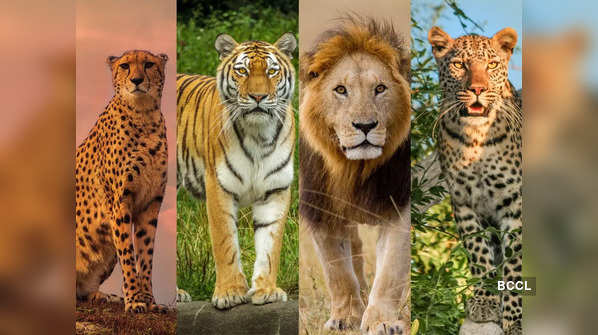
Iconic big cats
Cheetah, tiger, lion, and leopard are four of the most iconic and charismatic members of the cat family. They are often admired for their strength, speed, beauty, and grace. However, despite their similarities, these big cats have many differences that make them unique and distinct from each other. In this article, we will explore some of the main differences between cheetahs, tigers, lions, and leopards in terms of their physical appearance, behaviour, habitat, and conservation status.
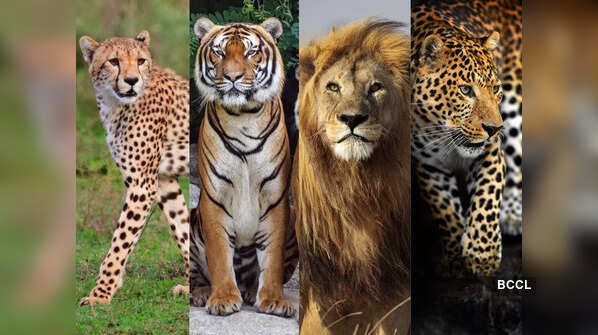
Physical appearance
The physical features of big cats play a crucial role in their survival and adaptation to diverse environments. From the lightning-fast cheetah to the regal lion, each species boasts a unique set of characteristics that define its appearance.
Cheetah: The cheetah has a light yellow or tan coat with black spots all over its body. It has a slender and streamlined body, long legs, and a long tail. It also has black tear marks on its face that run from the eyes to the mouth. The cheetah is the smallest of the four cats, with an average body length of 112 to 150 cm and a weight of 21 to 72 kg.
Tiger: The tiger has a reddish-orange or golden coat with black stripes that vary in shape, size, and number. It has a muscular and robust body, short legs, and a long tail. It also has white patches on its face, chest, and belly. The tiger is the largest of the four cats, with an average body length of 200 to 330 cm and a weight of 90 to 306 kg.
Lion: The lion has a sandy or light brown coat that is uniform in colour, except for the belly and chest, which are slightly lighter. It has a powerful and stocky body, medium legs, and a long tail. It also has a mane of long hair around its neck and head, which is more prominent in males than in females. The lion is the second largest of the four cats, with an average body length of 170 to 250 cm and a weight of 120 to 191 kg.
Leopard: The leopard has a yellowish-brown or golden coat with black rosettes that are smaller and more densely packed than those of the jaguar. It has a sleek and agile body, long legs, and a long tail. It also has a small head and ears, and a short muzzle. The leopard is the most variable of the four cats, with an average body length of 90 to 190 cm and a weight of 17 to 70 kg.
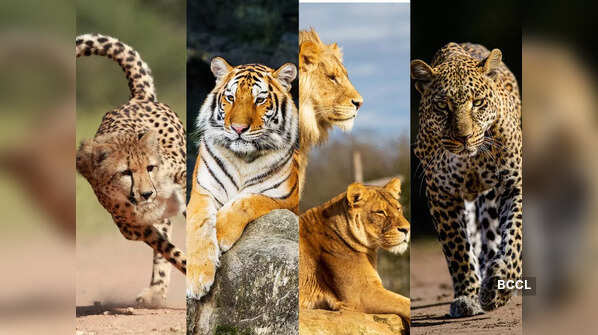
Behaviour
The behaviors exhibited by cheetahs, tigers, lions, and leopards offer a glimpse into their social structures, hunting strategies, and overall survival instincts. Understanding their distinct behaviors provides insight into their roles within their ecosystems.
Cheetah: The cheetah is the fastest land animal, capable of reaching speeds of up to 120 km/h in short bursts. It hunts mostly during the day, using its speed and vision to chase down its prey, which consists mainly of small to medium-sized ungulates. The cheetah is a solitary animal, except for mothers with cubs and males that form coalitions. The cheetah communicates with a range of sounds, such as purrs, chirps, hisses, and growls. The cheetah has a gestation period of about 90 to 95 days, and gives birth to a litter of two to eight cubs.
Tiger: The tiger is the most powerful and skilled of the four cats, capable of killing prey larger than itself. It hunts mostly at night, using its stealth and strength to ambush its prey, which consists mainly of large ungulates and occasionally smaller animals. The tiger is a solitary animal, except for mothers with cubs and males that mate with multiple females. The tiger communicates with a range of sounds, such as roars, snarls, grunts, and moans. The tiger has a gestation period of about 103 to 105 days, and gives birth to one to six cubs at a time.
Lion: The lion is the most social and cooperative of the four cats, capable of forming large groups called prides. It hunts mostly at dusk and dawn, using its teamwork and strategy to bring down its prey, which consists mainly of large ungulates and occasionally smaller animals. The lion is a social animal, living in prides of up to 40 individuals, consisting of related females, their offspring, and a few males. The lion communicates with a range of sounds, such as roars, snarls, grunts, and purrs. The lion has a gestation period of about 110 days, and gives birth to one to six cubs.
Leopard: The leopard is the most adaptable and versatile of the four cats, capable of living in a wide range of habitats and climates. It hunts mostly at night, using its speed and agility to catch its prey, which consists of a variety of animals, from rodents to antelopes. The leopard is a solitary animal, except for mothers with cubs and males that mate with multiple females. The leopard communicates with a range of sounds, such as roars, snarls, growls, and coughs. The leopard has a gestation period of about 90 to 105 days, and gives birth to one to six cubs.
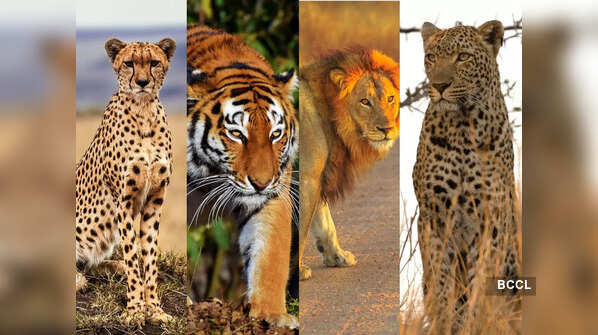
Habitat
The choice of habitat is a critical factor influencing the lifestyle and survival of big cats. From the open savannahs favored by cheetahs to the dense forests inhabited by tigers, each species has adapted to specific environments throughout evolution.
Cheetah: Cheetahs are well-adapted to open grasslands and savannahs, where their speed and agility are crucial for hunting. They can also be found in semi-arid regions.
Tiger: Tigers are highly adaptable and inhabit a variety of ecosystems, including dense forests, grasslands, and mangrove swamps. The specific habitat depends on the tiger species, such as the Bengal tiger, Siberian tiger, and Sumatran tiger.
Lion: Lions primarily inhabit the grasslands and savannahs of sub-Saharan Africa, forming pride that establishes territories in these expansive regions.
Leopard: Leopards are incredibly versatile and can thrive in various environments, including rainforests, deserts, and mountains. Their adaptability makes them one of the most widespread big cat species.
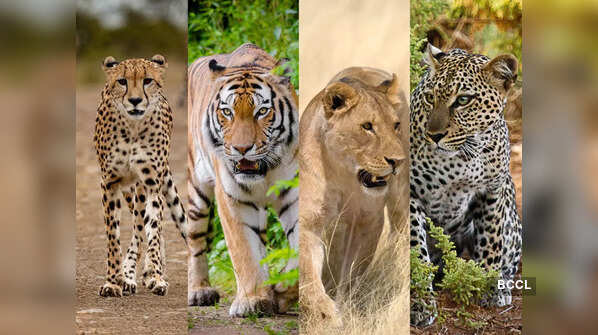
Conservation status
As the world grapples with environmental challenges, the conservation status of big cat species becomes a pressing concern. Examining the threats faced by cheetahs, tigers, lions, and leopards sheds light on the urgency of conservation efforts.
Cheetah: Cheetahs are listed as vulnerable on the International Union for Conservation of Nature (IUCN) Red List. Threats to their population include habitat loss, human-wildlife conflict, and the illegal pet trade.
Tiger: Tiger species face varying conservation statuses, with the Sumatran tiger classified as critically endangered. Tigers are threatened by habitat loss, poaching, and human-wildlife conflict.
Lion: Lions are classified as vulnerable on the IUCN Red List. Habitat loss, human-wildlife conflict, and trophy hunting contribute to the decline in their populations, particularly in West Africa.
Leopard: Leopard conservation statuses differ among subspecies, with some listed as near-threatened. Similar to other big cats, leopards face threats from habitat loss, poaching, and conflicts with humans.
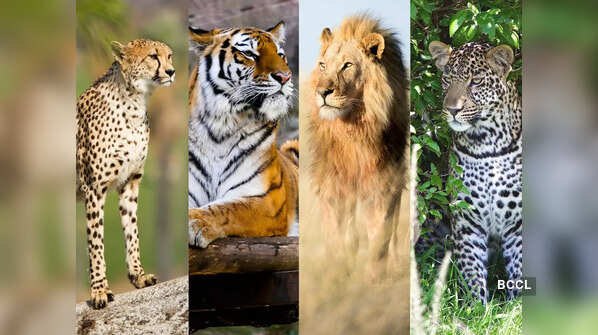
Lifespan
The lifespan of big cats varies among species, reflecting their adaptations, environmental conditions, and the challenges they face. Exploring the lifespans of cheetahs, tigers, lions, and leopards provides valuable insights into their life cycles.
Cheetah: In the wild, cheetahs typically live between 8 to 10 years. Captive cheetahs may have a longer lifespan, reaching up to 20 years.
Tiger: Tigers in the wild have an average lifespan of 10 to 15 years. In captivity, they may live slightly longer, with some individuals reaching their early twenties.
Lion: Wild lions generally have a lifespan of 10 to 14 years. In captivity, lions may live longer, with some reaching their late teens or early 20s.
Leopard: Leopards in the wild have a lifespan of around 12 to 15 years. In captivity, they may live up to 20 years.
Discover the unique traits that distinguish cheetahs, tigers, lions, and leopards. From the cheetah's lightning speed to the lion's majestic mane, explore their differences in appearance, behavior, habitat, conservation status, and lifespan in this concise guide to the world of big cats.









